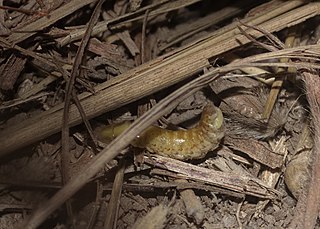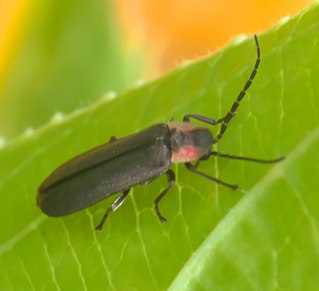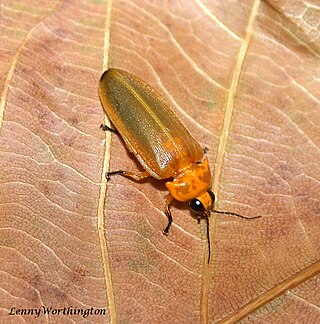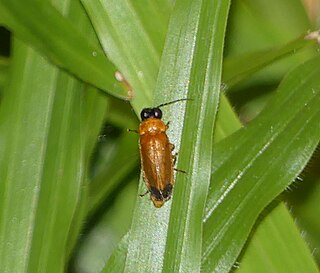
The Lampyridae are a family of elateroid beetles with more than 2,000 described species, many of which are light-emitting. They are soft-bodied beetles commonly called fireflies, lightning bugs, or glowworms for their conspicuous production of light, mainly during twilight, to attract mates. Light production in the Lampyridae is thought to have originated as an honest warning signal that the larvae were distasteful; this was co-opted as a mating signal in the adults. In a further development, female fireflies of the genus Photuris mimic the flash pattern of Photinus species to trap their males as prey.
Larviform female is a biological phenomenon occurring in some insect species, where the females in the adult stage of metamorphosis resemble the larvae to various degrees, while the male appears more morphologically adult. The resemblance may mean the larviform female has the same coloring as the larvae and/or similar body plans, and may be the result of the female arresting development at earlier stages of ecdysis than males. The female may not pupate at all, as in Xenos vesparum. Typically, the female is wingless and generally larger than the male. Larviform females still reach sexual maturity. Larviform females occur in several insect groups, including most Strepsiptera and Bagworm moths, many elateroid beetles, and some gall midges.

The Rhagophthalmidae are a family of beetles within the superfamily Elateroidea. Members of this beetle family have bioluminescent organs on the larvae, and sometimes adults, and are closely related to the Phengodidae, though historically they have been often treated as a subfamily of Lampyridae, or as related to that family. Some recent evidence suggested that they were the sister group to the Phengodidae, and somewhat distantly related to Lampyridae, whose sister taxon was Cantharidae, but more reliable genome-based phylogenetics placed as the sister group to the Lampyridae.

Luciola is a genus of flashing fireflies in the family Lampyridae. They are especially well known from Japan and are often called Japanese fireflies, but their members range farther into Asia and reach southern Europe and Africa. This genus is traditionally held to extend to Australia, but these species do not seem to belong herein.

The Luciolinae are among the largest subfamilies of fireflies (Lampyridae). They seem to be all "flashing" fireflies. They are a diverse lineage, spreading throughout the warm parts of Eurasia into temperate Europe and East Asia and south to the Australian region.
Atyphella is a genus of 'flashing' firefly found in the Australasian region, particularly in the eastern and northern regions of Australia. The genus consists of 23 recognized species, 14 considered to be endemic to Australia.
Atyphella dalmatia is a species of firefly in the genus Atyphella. It was discovered in 2009.
Aquatica ficta is a species of firefly found in Taiwan and parts of China. It was formerly placed in the genus Luciola. Its habitat is still water, and the larvae are aquatic.
Aquatica is a genus of fireflies in the subfamily Luciolinae. The species are found in China, Taiwan, Japan, Russia and Korea. Fu, Ballantyne and Lambkin erected the genus in 2010, using phylogenetic, morphological and behavioural evidence. Its type species is Aquatica wuhana. It contains five species:
Aquatica hydrophila is a species of firefly found in Taiwan. Described in 2003, it was formerly placed in the genus Luciola. The larvae are aquatic and live in ditches and small streams.

Aquatica lateralis, known as "heike-botaru" (ヘイケボタル) in Japanese, is a species of firefly found in Russia, Japan and Korea. It was formerly placed in the genus Luciola. The larvae are aquatic and live in rice paddies.
Microphotus is a genus of fireflies in the family Lampyridae. Microphotus are usually found in the southwestern region of the United States of America and adjoining parts of Mexico. There are seven described species in Microphotus in the United States and three more in Mexico.

Pyropyga is a genus of primarily North American fireflies in the beetle family Lampyridae. There are about 13 described species in Pyropyga. It is among the genera of Lampyridae where both sexes of adults have no bioluminescent organs.
Bicellonycha is a genus of fireflies in the beetle family Lampyridae. There are more than 40 described species in Bicellonycha.
Abscondita chinensis, is a species of firefly beetle found in India, China and Sri Lanka.
Abscondita promelaena is a species of firefly beetle found in India and Sri Lanka.
Luciola candezei, is a species of firefly beetle found in Sri Lanka.

Pteroptyx is a genus of fireflies in the subfamily Luciolinae found in Southeast Asia. It has long been noted for the ability to perform synchronous flashing, though not all species synchronize. These synchronizing species have been found on so-called 'firefly trees' and created a growing firefly-watching tour industry in some regions. Species of the genus have been identified in Malaysia, Thailand, the Philippines, and Hong Kong.

Abscondita is a genus of fireflies in tropical Asia. Species in the genus were earlier placed in the genus Luciola but molecular phylogeny studies support their separation.

Asymmetricata is a genus of fireflies found in tropical Asia. Species in the genus were formerly included in the genus Luciola. The genus was created in 2009 by Lesley Ballantyne who noted the asymmetric 8th abdominal tergite, emarginated on its left, as a shared feature. Adults of both males and females are winged. The larvae have been reliably described only in A. circumdata. They are terrestrial carnivores, feeding on snails and earthworms in moist soil below tree cover. The last abdominal segment bears an anchoring structure or pygopod with 58 or more pygopodia arising from it.







